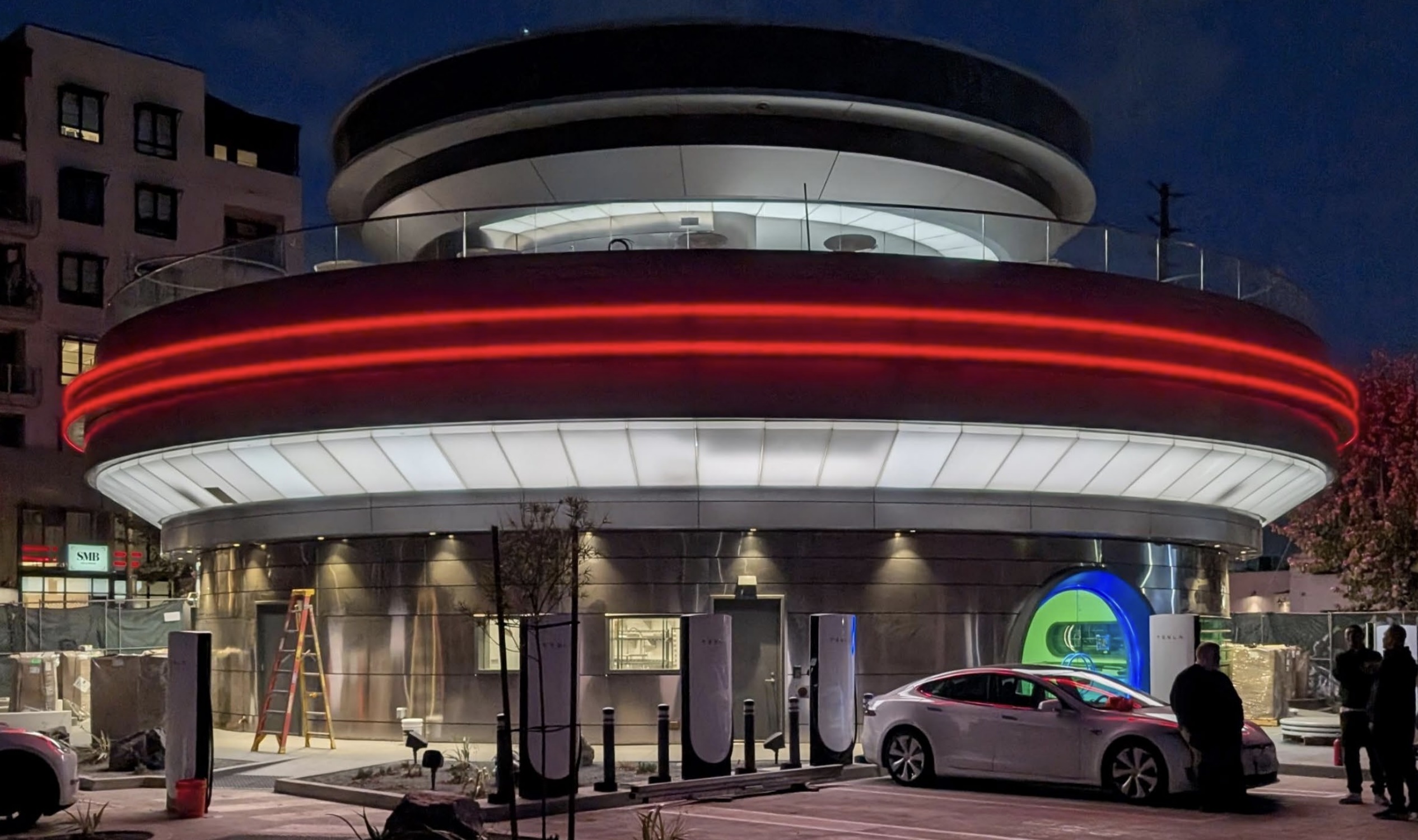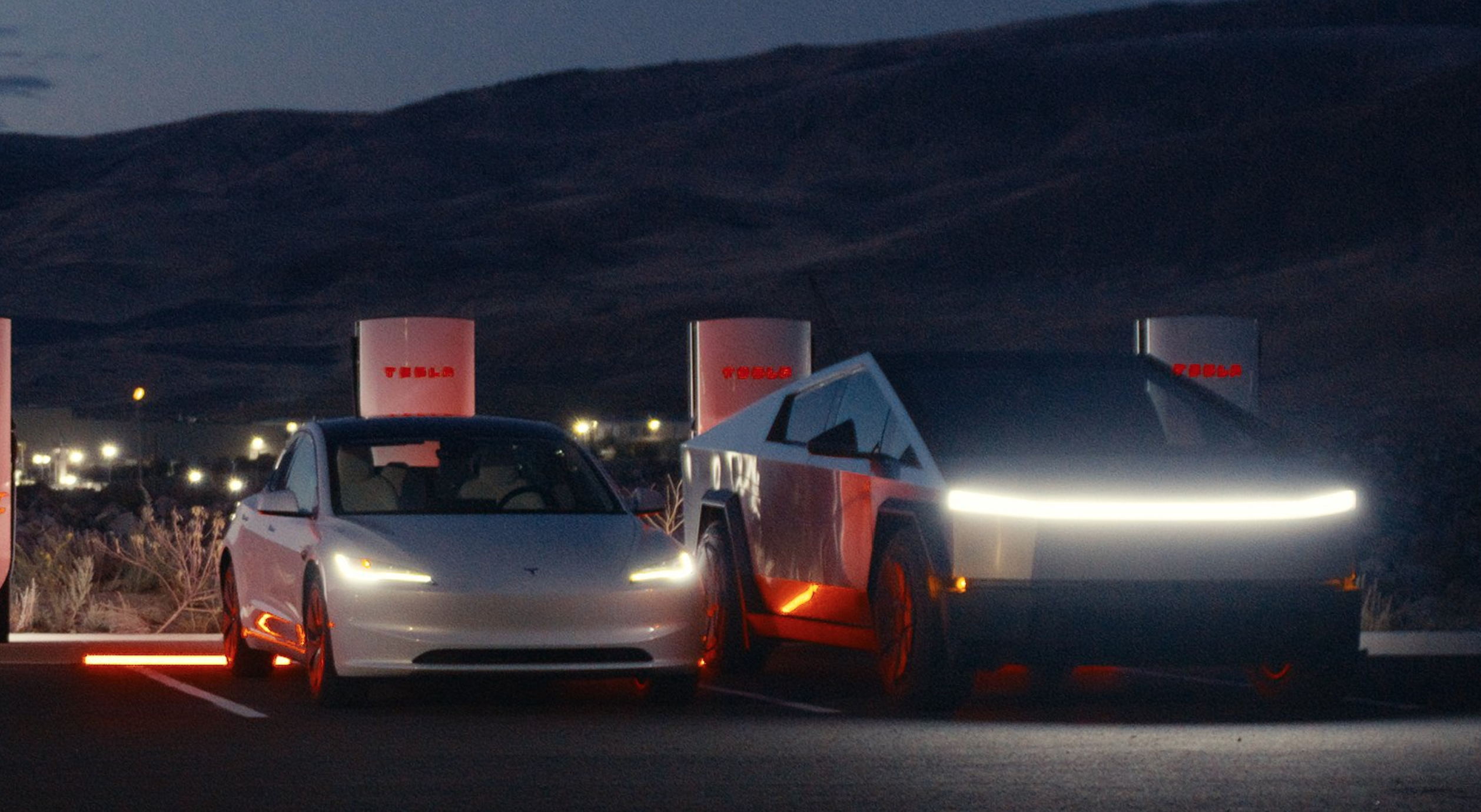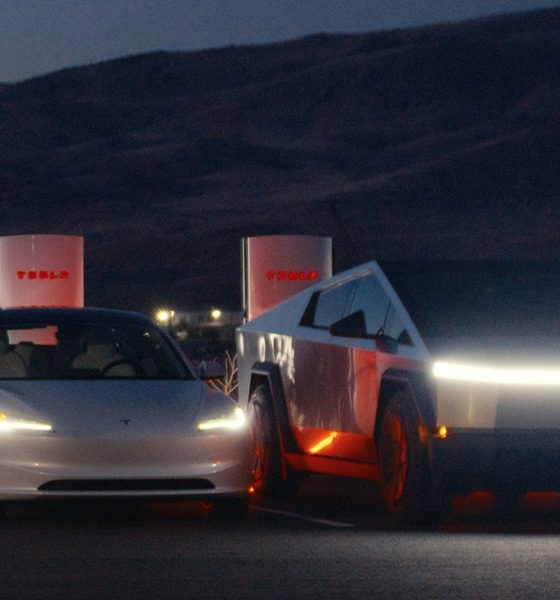Ahead of the rollout of V4-compatible power cabinets, Tesla has highlighted that faster charging speeds for the Cybertruck are now available at certain charging stations with V4 Supercharging posts.
On Friday, Tesla’s Charging account on X highlighted that the Cybertruck can now charge at speeds of up to 325kW at select Supercharger sites with V4 charging stalls. The news comes as Tesla prepares to start rolling out its V4 charging cabinets in early 2025, which will enable speeds of up to 500kW.
Tesla North American Charging Director Max de Zegher also reposted the news on X, clarifying that, eventually, all V4 posts with a V3 cabinet would enable 325kW charging speeds, and likely even in the coming weeks. He also points out that these Cybertrucks are charging at 400v at 325kW, though they’ll eventually be able to access the full capabilities of their 800v charging architecture with the arrival of the V4 cabinet.
Where can Tesla Cybertrucks charge at speeds of up to 325kW?
Below is the full list of initial sites where Tesla Cybertrucks can charge at 325kW, as shared by Tesla. The company also says it’s aiming to roll out access to even more locations.
- Lebec, CA
- Chemult, OR
- Columbus, GA – Macon Road
- Dayton, OH – North Springboro Pike
- Dunnigan, CA – County Road
- Lamoni, IA
- Wilsonville, OR
- Truckee, CA – Deerfield Drive
- Harrison, NY
- Farr West, UT
- Tacoma, WA – S 40th Street
- Highland, CA – 4154 E Highland Ave
- Melissa, TX
- Cedar Park, TX – East Whitestone Boulevard
- Gillette, WY – South Douglas Highway
- Rockaway, NJ – Green Pond Road
- Mesa, AZ – South Signal Butte Road
- Blaine, WA – Boblett Street
- Santa Ynez, CA
Tesla’s latest charging improvements and milestones
Tesla quietly started rolling out its upgraded V4 Superchargers in North America and other markets throughout much of last year, though the community was quick to point out that the power cabinets also required updates to allow for faster charging speeds. In August, however, Tesla did confirm that it was performing trials of faster charging speeds on the V4 stalls at select Supercharger locations, hinting that these updates were not far off and that even sites with V3 cabinets would likely soon access faster charging.
In the past, Tesla and de Zegher have also highlighted the advantages of building prefabricated charging units at the Gigafactory in Buffalo, New York, which come in pre-built structures with four stall units that are delivered to the site. For one, Tesla has said that the prefab units now take the company just four days from delivery to installation, meaning that it can deploy charging stations faster than ever.
Ultimately, the charging executive also says that the cost-savings that come from building Supercharger stalls this way will be passed onto the customer, following suit recent price reductions that have been spotted in both the North American and European markets in recent weeks.
You can see a rendering of the total supplies needed for four V4 Supercharger stalls (left) compared to the pre-assembled Supercharger units (right) below.
Credit: Max de Zegher | X
What are your thoughts? Let me know at zach@teslarati.com, find me on X at @zacharyvisconti, or send us tips at tips@teslarati.com.
Tesla Supercharger network leads U.S. toward 2030 charging goal



News
Tesla Diner to transition to full-service restaurant as Chef heads for new venture
“I am leaving the Tesla Diner project to focus on the opening of Mish, my long-desired Jewish deli. Projects like Mish and the Tesla Diner require a sharpness of focus and attention, and my focus and attention is now squarely on Mish.”

Tesla Diner, the all-in-one Supercharging and dining experience located in Los Angeles, will transition to a full-service restaurant in January, staff said, as Chef Eric Greenspan said he would take on a new project.
A report from the Los Angeles Times says Greenspan confirmed through a text that he would leave the Diner and focus on the opening of his new Jewish deli, Mish.
Greenspan confirmed to the paper:
“I am leaving the Tesla Diner project to focus on the opening of Mish, my long-desired Jewish deli. Projects like Mish and the Tesla Diner require a sharpness of focus and attention, and my focus and attention is now squarely on Mish.”
Greenspan took on the job at the Tesla Diner and curated the menu back in March, focusing on locally-sourced ingredients and items that would play on various company products, like Cybertruck-shaped boxes that hold burgers.
Tesla Cybertruck leftovers are the main course at the Supercharger Diner
The Tesla Diner has operated as somewhat of a self-serve establishment, where Tesla owners can order directly from their vehicles through the center touchscreen. It was not exclusive to Tesla owners. Guests could also enter and order at a counter, and pick up their food, before sitting at a booth or table.
However, the report indicates Tesla is planning to push it toward a sit-down restaurant, full of waiters, waitresses, and servers, all of which will come to a table after you are seated, take your order, and serve your food.
It will be more of a full-featured restaurant experience moving forward, which is an interesting move from the company, but it also sounds as if it could be testing for an expansion.
We know that Tesla is already considering expanding locations, as it will be heading to new areas of the country. CEO Elon Musk has said that Tesla will be considering locations in Palo Alto near the company’s Engineering HQ, and in Austin, where its HQ and Gigafactory Texas are located.
Musk said that the Diner has been very successful in its first few months of operation.
News
Tesla adds new surprising fee to Robotaxi program
“Additional cleaning was required for the vehicle after your trip. A fee has been added to your final cost to cover this service. Please contact us if you have any questions.”

Tesla has added a new and somewhat surprising fee to the Robotaxi program. It’s only surprising because it was never there before.
Tesla shocked everyone when it launched its Robotaxi platform and offered riders the opportunity to tip, only to tell them they do not accept tips. It was one of the company’s attempts at being humorous as it rolled out its driverless platform to people in Austin.
As it has expanded to new cities and been opened to more people, as it was yesterday to iOS users, Tesla has had to tweak some of the minor details of the Robotaxi and ride-hailing platforms it operates.
First Look at Tesla’s Robotaxi App: features, design, and more
With more riders, more vehicles, and more operational jurisdictions, the company has to adjust as things become busier.
Now, it is adjusting the platform by adding “Cleaning Fees” to the Robotaxi platform, but it seems it is only charged if the vehicle requires some additional attention after your ride.
The app will communicate with the rider with the following message (via Not a Tesla App):
“Additional cleaning was required for the vehicle after your trip. A fee has been added to your final cost to cover this service. Please contact us if you have any questions.”
The cost of the cleaning will likely depend on how severe the mess is. If you spill a soda, it will likely cost less than if you lose your lunch in the back of the car because you had a few too many drinks.
This is an expected change, and it seems to be one that is needed, especially considering Tesla is operating a small-scale ride-hailing service at the current time. As it expands to more states and cities and eventually is available everywhere, there will be more situations that will arise.
The messes in vehicles are not a new situation, especially in a rideshare setting. It will be interesting to see if Tesla will enable other fees, like ones for riders who request a ride and do not show up for it.
News
Tesla Model Y sold out in China for 2025
Customers who wish to get their cars by the end of the year would likely need to get an inventory unit.

It appears that the Model Y has been sold out for 2025 in China. This seems to be true for the four variants of the vehicle that are currently offered in the country.
Tesla China’s order page update
A look at Tesla China’s order page for the Model Y shows a message informing customers that those who wish to guarantee delivery by the end of the year should purchase an inventory unit. This was despite the Model Y RWD and Model Y L showing an estimated delivery timeline of 4-8 weeks, and the Model Y Long Range RWD and Model Y Long Range AWD showing 4-13 weeks.
As per industry watchers, these updates on the Model Y’s order page suggest that Tesla China’s sales capacity for the remainder of 2025 has been sold out. The fact that estimated delivery timeframes for the Model Y Long Range RWD and AWD extend up to 13 weeks also bodes well for demand for the vehicle, especially given strong rivals like the Xiaomi YU7, which undercuts the Model Y in price.
Tesla China’s upcoming big updates
What is quite interesting is that Tesla China is still competing in the country with one hand partly tied behind its back. So far, Tesla has only been able to secure partial approval for its flagship self-driving software, FSD, in China. This has resulted in V14 not being rolled out to the country yet. Despite this, Tesla China’s “Autopilot automatic assisted driving on urban roads,” as the system is called locally, has earned positive reviews from users.
As per Elon Musk during the 2025 Annual Shareholder Meeting, however, Tesla is expecting to secure full approval for FSD in China in early 2026. “We have partial approval in China, and we hopefully will have full approval in China around February or March or so. That’s what they’ve told us,” Musk said.










